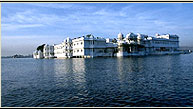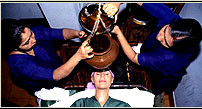-| Sanchi | -
Location: District Raisen (Madhya Pradesh) - Lat 23º 28'N, Long
77º 48'E

Sanchi is situated 45 kms. from Bhopal, the state capital of Madhya Pradesh.
The place has impressive Buddhist remains ranging from the 3rd century BC to
12th century AD that are situated on a hill top of Vindhya range in Central
India. The serene hill of Sanchi is crowned by a group of stupas, monasteries,
temples and pillars. The glorious past of Sanchi, as an ancient seat of Buddhist
learning and a place of pilgrimage, can still be experienced in its complex
structure where many Buddhist legends found expression in the rich sculptures.
Lord Buddha is not represented in the human form in the sculptures of Sanchi
but through the symbols – the lotus represents the Buddha's birth, the
tree signifies his enlightenment, the wheel represent his nirvana or salvation.
The foot prints and the throne denote the Buddha's presence.
Sanchi was virtually forgotten after 13th century AD until 1818. A British officer
rediscovered it half buried. Later in 1912, Archaeological Survey of India started
conservation and preservation of the monuments. There are 53 monuments of different
periods at this site.
The great and imposing main stupa (Stupa no.1) of Sanchi has a diameter of 36.5
meter and is 16.4 meter high. It is one of oldest stone masonry structures in
India. With a massive hemispherical dome, the stupa stands majestically with
four gateways adjoining the great stupa. It was originally built as an earthen
stupa by Emperor Ashoka. It was rebuilt in the 3rd and 2nd century BC. The Last
of the additions to this remarkable stupa are the elaborate and richly carved
four gateways. These gateways are embellished with narrative stories on stone
slabs from Jatakas, the stories from the previous birth of Buddha.
The southern gate depicts the birth of Gautam in a series of dramatically rich
carving in low relief. The northern gateway is crowned by a wheel of law and
illustrates the miracles associated with the Buddha as told in the Jatakas stories.
The eastern gateway depicts the young prince Gautam, leaving his father's palace
renouncing worldly life to seek enlightenment. The inner face of the right pillar
portrays the dream of Maya. Stupa no.3 situated northeast of the great stupa
is where the relics of the Sriputra and Mahamogalana – two famous disciples
of Lord Buddha, were found in its innermost chambers.
Ashoka Pillar, with its four lion head stump, was erected during the 3rd century
BC and is situated close to the southern gateway of the great stupa. There are
other temples, monasteries and stupas of later period.




